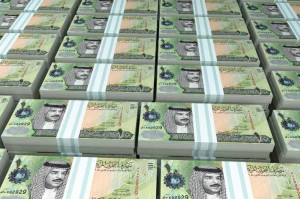 A ‘gradual weakening in economic conditions’ may adversely affect Gulf banks, according to rating agency Standard & Poor.
A ‘gradual weakening in economic conditions’ may adversely affect Gulf banks, according to rating agency Standard & Poor.
After posting positive results in the past year, Islamic banks in the UAE and the rest of the Gulf Cooperation Council (GCC) region are likely to see profits slowing down for what remains of this year as the decline in oil revenues casts a shadow over the growth of regional economies.
According to a report published recently by Standard & Poor’s Rating Services, the “gradual weakening in economic conditions” will “adversely” affect the banking industry in the region. It believes that growth of net income and deposits in Gulf-based Islamic banks will slow down, while asset quality may be seen to deteriorate.
Since June last year, global oil prices have been falling and a strong recovery in the near term seems unlikely, says S&P. It predicts that prices will also remain “relatively weak through 2016”, with Brent crude forecast to average $55 per barrel in 2015, $65 in 2016 and about $75 in 2017.
“Given the importance of oil-related revenues to the region’s economies, the ensuing gradual weakening in economic conditions for the sovereign states that make up the GCC – Bahrain, Kuwait, Oman, Qatar, Saudi Arabia and the UAE – will in our view adversely affect their banking sectors,” S&P said in a statement.
Sources in the industry have said that liquidity conditions in the country are already tight. “There seems to be a worrying trend. Government and public sector deposits are declining. Certificates of deposits issued to absorb excess liquidity in the sector have been declining as well. All these signal a tightening liquidity condition,” Alp Eke, senior economist at the National Bank of Abu Dhabi (NBAD),is reported to have told Gulf News.
NBAD’s June 2015 UAE banking sector overview noted that the government and public sector deposits, Central Bank foreign exchange reserves, loan to deposit ratios and liquidity in the banking system are already showing some “less than positive signs”.
Timucin Engin, S&P’s credit analyst, said that as a result of the weakness in oil prices and its effects on GCC economies, the operating conditions for Islamic banks in the region will change gradually.
“Although our credit growth projections remain largely unchanged for 2015, we believe deposit growth will slow somewhat due to relatively weaker liquidity conditions and asset quality will gradually deteriorate in line with the economic slowdown.”
 S&P’s credit analyst Suha Urgan added, “These factors will in our view gradually increase credit losses at Islamic banks in 2015, leading to lower net income growth than in 2014.
S&P’s credit analyst Suha Urgan added, “These factors will in our view gradually increase credit losses at Islamic banks in 2015, leading to lower net income growth than in 2014.
“Given that Islamic banks generally operate with healthy funding and capital positions, we expect them now to adopt a conservative stance and maintain strong levels of capital while looking to further diversify their funding base.”
S&P, however, noted that demand for Sharia-compliant products and supportive government actions will still enable Islamic banks to continue to grow and gradually increase their market share.
“We expect 2015-2016 to be relatively less benign for Gulf Islamic banks in general, although we still believe the long-term supportive factors for these banks remain unchanged.”
Among the GCC economies, S&P said that the UAE, Qatar and Saudi Arabia continue to offer the “strongest growth opportunities” in the region.
Bahrain’s high hopes for SMEs
Despite the downcast wider picture, Bahrain still plans to increase small-and-medium-sized enterprises’ contribution to the national economy through the Bahrain Economic Vision 2030, Abdel Kareem Al Rashid, under-secretary of the kingdom’s Ministry of Industry and Commerce (MOIC), has said.
He explained that the government is to endeavour to raise the SME sector’s GDP contribution to 35 per cent in the next three years, from the current 30 per cent. SMEs have also been important job creators, “accounting for 37 per cent of the private sector’s employment opportunities”.
Investments in Bahraini SMEs grew by almost 55 per cent to BHD 49 million ($130m) in the first half of 2015, compared with BHD 31.7 million ($84.1m) in the same period a year before, according to the Bahrain Development Bank (BDB).
“There is a system in place in Bahrain to support the growth of SMEs, such as the employment fund Tamkeen, the BDB, Bahrain Chamber of Commerce and Industry, in addition to agencies providing SMEs with development, funding, consulting and training programmes,” Al Rashid said.
Micro-financing pays off
In 2010, Bahrain launched Ebdaa Microfinance Bank, the first financial institution to provide micro-financing assistance in the Arabian Gulf region. The initiative is said to have “empowered the less fortunate segments of society by helping them improve their living conditions through entrepreneurship supported by a financial package, as well as consultancy services”.
Al Rashid added that the programme is available only to Bahraini enterprises established in the kingdom as a way to encourage citizens to explore entrepreneurial activities and help reduce unemployment figures.
As for the MOIC, whilst it actively supports efforts to advance the SME sector, it does not provide financial support to small-and-medium businesses. It is, however, implementing partnership programmes that act as a link between SMEs and big companies in Bahrain. Their aim is to create opportunities for SMEs by encouraging large companies to source locally the products and services that they usually import.
 Cash And Trade Magazine For Cash and Trade professionals in the Middle East
Cash And Trade Magazine For Cash and Trade professionals in the Middle East




